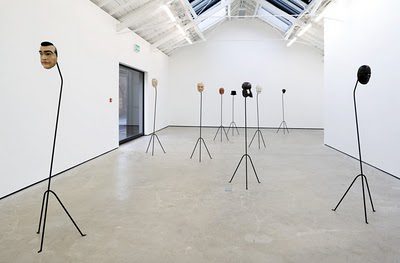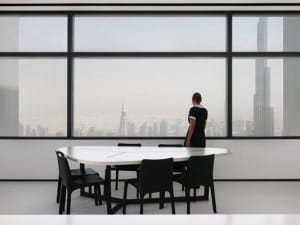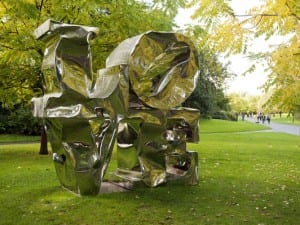Review by Alistair Quietsch
On 10 December, I read yet another apocalyptically tinged news report: that of Burma building silos with aid from North Korea. Now I know this is not a scare mongering news site, and realise people don’t come here to be dragged down by such reportage, but after seeing the recent Simon Starling show, Project for a Masquerade (Hiroshima): The Mirror Room at The Modern Institute in Glasgow you will see why such news is relevant.
The title of the show lays the groundwork for some comment on “The Bomb”, however on arrival I was surprised at the stillness and ambiguity of the silent masks that meet you. This is the first part of a two-part exhibition to be realised at The Modern Institute and Hiroshima City Museum of Contemporary Art, where Starling will exhibit in January 2011.
Walking into the main space you are confronted by a large mirror and eight handcrafted Japanese masks (by skilled mask maker Yasuo Miichi from Osaka, Japan) all staring eerily at you and their own reflections. Ahead of them, hidden from their view, are three photographs all of the Henry Moore sculpture Atom Piece (1964-65), which, as an art piece, is an integral part of the conceptual puzzle that Starling has laid out.
I was weary of getting so little from the pieces on display and having to go straight to the books to gain more of an understanding and essentially a sterile reaction, as is the case with many heavy conceptual pieces, but these works offered so much on so many levels. Are they victims of “The Bomb”? Are they a comment on the viewer/work relationship? Such is the constant downfall of conceptual works. When confronted with masks of James Bond, Colonel Sanders and traditional Japanese villains cryptically renamed Joseph Hirshhorn, (while also reading the introductory blurb describing the traditional “possession” of Japanese Noh actors) any obvious connection seems very distant.
The booklet though (a vital 20 page addition to the show) slowly brings these characters together in a fascinating, almost movie script narrative. As previously assumed the title does refer to the atom bomb, (asking the question, how can that city’s name not bring about that daunting recollection?) and the tradition of the Noh Theatre actors possession before the mirror prior to the stage conjured infant thoughts of the art pieces preparing to be unfurled, unwrapped and dissected by the viewer.
It is an intelligent move on Starling’s part to suspend these masks, not simply in stuffy glass cabinets, but instead propped on thin tripods at a human height to stare you and the mirror down deafeningly as they draw the viewer in to hear (or read as the case may be) their story.
The tale and histories are a complicated interconnection of art, espionage and the making of the first atom bomb, all written out in a new and captivating narrative, like a twisting whodunit plot. The cast is made of the unlikely characters of James Bond, Henry Moore, the famous English wartime sculptor, Anthony Blunt, the art historian and Russian spy, Colonel Sanders, of the Kentucky Fried Chicken chain and Joseph Hirshhorn, who as some of you will know was one of the biggest collectors of art in the North East of America, but who was also closely connected with the illegal mining of uranium in Canada. As you read through the booklet (written entirely by Starling) slowly you start to unravel each characters connection with one another, their role in the art world and their final connections with The Bomb.
One humorous example is the drawn out connection of James Bond to the art world, where the villain Auric Goldfinger from Ian Fleming’s novel was based on Erno Goldfinger, the Hungarian Architect who later met Henry Moore in the cultural melting pot of London’s Hampstead in the 1920s.
The show is the first of a two-part exhibition, with the latter scheduled to take place in Hiroshima City Museum of Contemporary Art in January 2011, and my initial feeling was that Starling is only giving a glimpse of the end product to come; of actors before their roles or some “behind the scenes” special feature, always entertaining, but not the main feature.
On reflection (since the play itself is never acted out) you can understand the line “This publication is an integral part of the exhibition” at the end of the booklet, because if this play were staged you’d have to break down each character’s background before even introducing them to the set. It is a hindrance that the show lacks that immediacy of emotion but makes up for it with its allure of plot, character and in the intricacy and care taken over the engaging wooden masks.
It is a fact that ruminations on subjects like Hiroshima and the threat of nuclear war is something that you don’t just quickly digest and throw away, but rather it’s something you sit with patiently, as if you were defusing a bomb.
Through Starlings’ play with characters, histories, and his success in finding new connections to well documented events, he retells a story that, though told over and over again, as journalist I. F. Stone once said “has to be told again and again.”
The show has now finished in Glasgow, but for details on the opening at Hiroshima City Museum of Contemporary Art (22 January – 10 April 2011 visit the website or for further information on Simon Starling visit The Modern Institute.





